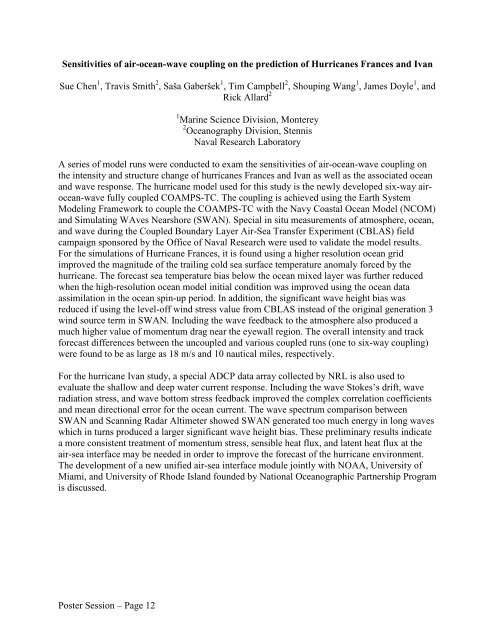65th IHC Booklet/Program (pdf - 4.9MB) - Office of the Federal ...
65th IHC Booklet/Program (pdf - 4.9MB) - Office of the Federal ...
65th IHC Booklet/Program (pdf - 4.9MB) - Office of the Federal ...
You also want an ePaper? Increase the reach of your titles
YUMPU automatically turns print PDFs into web optimized ePapers that Google loves.
Sensitivities <strong>of</strong> air-ocean-wave coupling on <strong>the</strong> prediction <strong>of</strong> Hurricanes Frances and Ivan<br />
Sue Chen 1 , Travis Smith 2 , Saša Gaberšek 1 , Tim Campbell 2 , Shouping Wang 1 , James Doyle 1 , and<br />
Rick Allard 2<br />
1 Marine Science Division, Monterey<br />
2 Oceanography Division, Stennis<br />
Naval Research Laboratory<br />
A series <strong>of</strong> model runs were conducted to exam <strong>the</strong> sensitivities <strong>of</strong> air-ocean-wave coupling on<br />
<strong>the</strong> intensity and structure change <strong>of</strong> hurricanes Frances and Ivan as well as <strong>the</strong> associated ocean<br />
and wave response. The hurricane model used for this study is <strong>the</strong> newly developed six-way airocean-wave<br />
fully coupled COAMPS-TC. The coupling is achieved using <strong>the</strong> Earth System<br />
Modeling Framework to couple <strong>the</strong> COAMPS-TC with <strong>the</strong> Navy Coastal Ocean Model (NCOM)<br />
and Simulating WAves Nearshore (SWAN). Special in situ measurements <strong>of</strong> atmosphere, ocean,<br />
and wave during <strong>the</strong> Coupled Boundary Layer Air-Sea Transfer Experiment (CBLAS) field<br />
campaign sponsored by <strong>the</strong> <strong>Office</strong> <strong>of</strong> Naval Research were used to validate <strong>the</strong> model results.<br />
For <strong>the</strong> simulations <strong>of</strong> Hurricane Frances, it is found using a higher resolution ocean grid<br />
improved <strong>the</strong> magnitude <strong>of</strong> <strong>the</strong> trailing cold sea surface temperature anomaly forced by <strong>the</strong><br />
hurricane. The forecast sea temperature bias below <strong>the</strong> ocean mixed layer was fur<strong>the</strong>r reduced<br />
when <strong>the</strong> high-resolution ocean model initial condition was improved using <strong>the</strong> ocean data<br />
assimilation in <strong>the</strong> ocean spin-up period. In addition, <strong>the</strong> significant wave height bias was<br />
reduced if using <strong>the</strong> level-<strong>of</strong>f wind stress value from CBLAS instead <strong>of</strong> <strong>the</strong> original generation 3<br />
wind source term in SWAN. Including <strong>the</strong> wave feedback to <strong>the</strong> atmosphere also produced a<br />
much higher value <strong>of</strong> momentum drag near <strong>the</strong> eyewall region. The overall intensity and track<br />
forecast differences between <strong>the</strong> uncoupled and various coupled runs (one to six-way coupling)<br />
were found to be as large as 18 m/s and 10 nautical miles, respectively.<br />
For <strong>the</strong> hurricane Ivan study, a special ADCP data array collected by NRL is also used to<br />
evaluate <strong>the</strong> shallow and deep water current response. Including <strong>the</strong> wave Stokes’s drift, wave<br />
radiation stress, and wave bottom stress feedback improved <strong>the</strong> complex correlation coefficients<br />
and mean directional error for <strong>the</strong> ocean current. The wave spectrum comparison between<br />
SWAN and Scanning Radar Altimeter showed SWAN generated too much energy in long waves<br />
which in turns produced a larger significant wave height bias. These preliminary results indicate<br />
a more consistent treatment <strong>of</strong> momentum stress, sensible heat flux, and latent heat flux at <strong>the</strong><br />
air-sea interface may be needed in order to improve <strong>the</strong> forecast <strong>of</strong> <strong>the</strong> hurricane environment.<br />
The development <strong>of</strong> a new unified air-sea interface module jointly with NOAA, University <strong>of</strong><br />
Miami, and University <strong>of</strong> Rhode Island founded by National Oceanographic Partnership <strong>Program</strong><br />
is discussed.<br />
Poster Session – Page 12
















